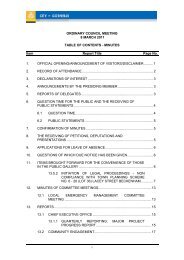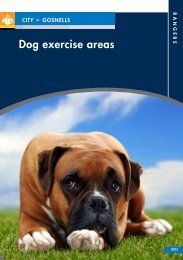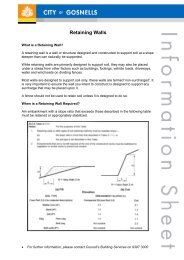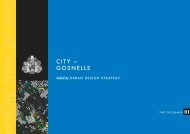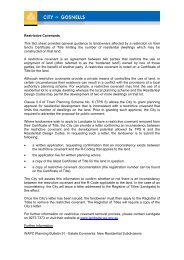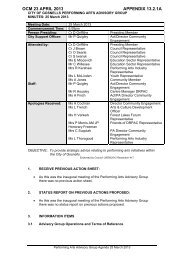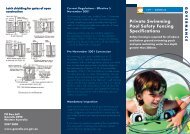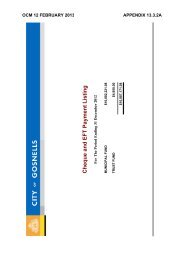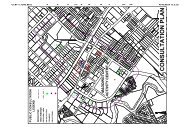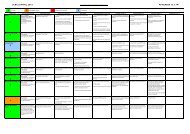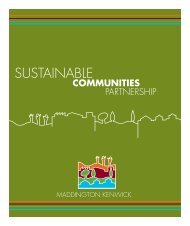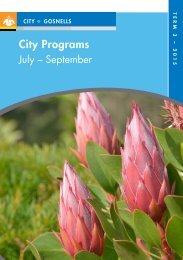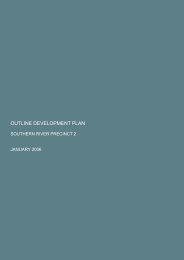Summary - City of Gosnells
Summary - City of Gosnells
Summary - City of Gosnells
You also want an ePaper? Increase the reach of your titles
YUMPU automatically turns print PDFs into web optimized ePapers that Google loves.
Vegetation 73that they may be underlain by Muchea Limestone. However, Site 20 showed evidence <strong>of</strong> calcareous materialin the shallow sediments.Sites 7 and 31 were narrow zones dominated by Pericalymma ellipticum that were not included in themultivariate analysis because they were thought to be transitional zones between other vegetation units.Pericalymma ellipticum dominated shrubs are not uncommon in BFS 387 (Table 4.4) where they occureither as an understorey in FCT 3a or as narrow zones on gentle slopes (as they do in Sites 7 and 31 in theMKSEA) that are flanked on the upland side by low lying Banksia woodland (FCT 21c) and downslope byspecies-rich rush/sedge/herblands <strong>of</strong> FCTs 7 and 8. MKSEA Sites 7 and 31 were most similar to FCT 10a, asinferred from species lists in Table 12 (Gibson et al., 1994).Assignation <strong>of</strong> FCTs (Table 5.5, Column 6a)Sites 4 and 5 were assigned to the Muchea Limestone TEC as this best reflected the total data available forthis area.Sites 6 and 14 were assigned to FCTs 7/8 as apart from their species-richness and the results <strong>of</strong> the floristicanalysis which tended to indicate FCT 8, they were inundated for a lengthy period each spring and theyincluded aquatic species.Sites 20 and 21 were assigned to the Muchea Limestone TEC as this best reflected the total data available forthis area.Site 18 was cleared shortly after the survey; the floristics indicated FCT 8 or 10a.Sites 8 and 11 were species-rich with numerous shrubs as well as geophytes, did not include aquatic speciesand were not inundated (except for short periods after rain). The floristic analysis indicated an affinity withFCT 8 and the ecological data with FCT 10a. These sites were tentatively assigned to FCTs 8/10a.Sites 9, 10 and 18 were species-rich with annuals and geophytes, did not include aquatic species and werenot inundated (except for short periods after rain). The floristic analysis indicated an affinity with FCT 8, theecological data with FCT 10a and floristic indicator species (except for Site 18) with ML. Sites 9 and 10were tentatively assigned to FCTs 8/10a/ML pending further hydrogeological investigation.Sites 7 and 31 were tentatively assigned to FCT 10a, as inferred from species lists in Table 12 (Gibson et al.,1994).From the above, the vegetation <strong>of</strong> Sites 4, 5 and 20 should be regarded as part <strong>of</strong> the complex <strong>of</strong> vegetationtypes associated with the Muchea Limestone Threatened Ecological Community (EPBC CategoryEndangered). The other blocks that included sites provisionally assigned to FCTs 7, 8 or 10a require furtherhydrogeological investigations to determine the Muchea Limestone issue. Pending these investigations, all <strong>of</strong>the remnant vegetation <strong>of</strong> Sites 6, 8, 9, 10 and 11 Rd should be protected as representatives <strong>of</strong> the complex <strong>of</strong>FCTs (7, 8, 10a) that are part <strong>of</strong> the mosaic <strong>of</strong> very species-rich seasonal wetland vegetation <strong>of</strong> the GuilfordVegetation Complex.Group D. MLResultsThe MKSEA quadrat sites 15, 16 presented a very ambiguous pattern in relation to the SCP dataset and thevegetation <strong>of</strong> these sites was also unlike any other vegetation previously recorded in BFS 387 or BFS 53.The investigations in the current survey showed that an active spring (associated with Muchea Limestone)contributed to the maintenance <strong>of</strong> the wetland and vegetation at Sites 15, 16 and probably to some extent toSite 14. Unlike the other wetlands <strong>of</strong> the MKSEA that were investigated in this survey and other wetlands <strong>of</strong>BFS 387 (VCSRG, 2001) the water table <strong>of</strong> the wetlands at Sites 14 and 15 was constantly high, the arearemained waterlogged throughout the year and there was a layer <strong>of</strong> peat at the ground surface. Theunderstorey <strong>of</strong> Site 15 was dominated by the sedge Cyathochaeta teretifolia. This sedge is rare In the PerthMetropolitan Region this sedge is known from Whiteman Park, Lake Gnangara, Ellenbrook, Bullsbrook,Pinjar, Wanneroo and Muchea but is rare on the Pinjarra Plain and south <strong>of</strong> the Swan River. It is usuallyassociated with artesian springs or other hydrological settings that are uncommon on the SCP (for anexample <strong>of</strong> such unusual settings see the listing for the Egerton Mound Spring on pages 226-227 inGovernment <strong>of</strong> Western Australian, 2000). This species is no longer extant in many locations on SCP whereTauss, C. and Weston, A.S. (2010). The flora, vegetation and wetlands <strong>of</strong> the Maddington-Kenwick Strategic Employment Area.A survey <strong>of</strong> the rural lands in the vicinity <strong>of</strong> the Greater Brixton Street Wetlands. Report to the <strong>City</strong> <strong>of</strong> <strong>Gosnells</strong>, W.A. Version 18.04.10



